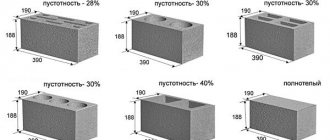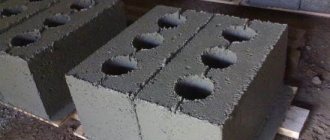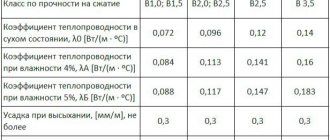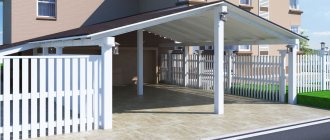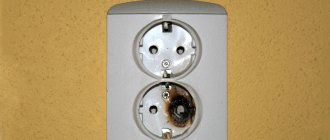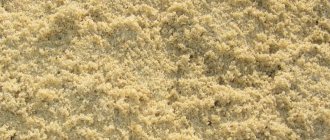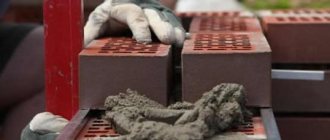Advantages and disadvantages of cinder block
The advantages of this wall material include:
- Relatively low price of the product.
- Due to the large size of one block, construction time is significantly reduced, which means the cost of work is reduced.
- The masonry technique is simple; you can do it yourself.
- A variety of filler compositions for concrete mixtures. You can always choose a material that suits its characteristics specifically for you.
- Long service life. Standard service life is 100 years.
- By using decorative cinder block, you do not need to spend money on plastering or cladding the building.
- High sound insulation. Like any concrete, cinder block absorbs sound.
Disadvantages of cinder blocks:
- Heavy weight of some types of products.
- Unsightly appearance. If you can’t buy decorative cinder blocks in your area, then it’s difficult to find a craftsman who can beautifully lay out this wall stone.
- After the Chernobyl accident, people began to treat this product with caution. There were, and still are, many rumors that the results of its testing for radioactivity can be unpredictable, and that the presence of a bouquet of elements of the periodic system in blast furnace slag can be potentially hazardous to health.
But whoever is forewarned is forearmed. And this very significant (maybe hypothetically) disadvantage can always be balanced by advantage No. 4.
The main thing is to approach the choice of manufacturer responsibly. Find out what equipment he uses, how production technology is followed, what filler he uses, and where it comes from.
Standard sizes and weight of cinder block
According to their purpose, cinder blocks are divided into:
- Wall, full block - solid and hollow . Standard cinder block size: 390×190×188 mm (length; depth; height)
- Wall, semi-block - hollow . It comes in two sizes: 390x120x188 mm and 390x90x188 mm.
- Wall blocks and semi-blocks with decorative surface . Special polyurethane molds allow you to obtain the front surface of the block with the texture of wild stone. At the moment, they began to produce colored products, the use of which significantly reduces the cost of construction not only of buildings, but also of site fencing.
How much does a cinder block weigh? Its weight varies greatly depending on its size, hollowness and manufacturer:
- The weight of a solid cinder block ranges from 25-28 kg.
- The weight of a hollow block is somewhere around 18-23 kg.
- The weight of the half-block is from 10 kg to 13 kg.
Advantages and disadvantages of such designs
The most key advantage of a cinder block structure is its low cost. The purchase of building materials and the construction of a “cinder block box” will not require significant financial and labor costs from the developer.
In addition, the main advantages of a house made of cinder blocks include:
- Possibility to implement any design project.
- The blocks are light in weight and do not weigh down the walls, so the house does not require a strong foundation.
- High fire-resistant characteristics of the wall material.
- Easy installation due to precise block shapes and large dimensions.
- Low specific costs of masonry material and low labor intensity of work.
- No special lifting and transport mechanisms are required.
- When using cinder blocks that meet the requirements of GOST and maintaining the technology of masonry work, the house turns out to be reliable and durable.
- Cinder block does not create an environment for mold to grow and is not susceptible to rodents.
- It is immune to ultraviolet degradation and can be exposed to chemical environments without damage.
The disadvantages of cinder block walls include
- Difficulty in carrying out installation work on introducing utility networks into the house.
- Increased ability to absorb moisture; hydro and vapor protection of walls is required.
- Low thermal and noise insulation characteristics, requires mandatory installation of external thermal protection.
- Increased fragility of walls, and therefore it is not recommended to install heavy equipment on the walls, for example, wall-mounted boilers or water heaters.
- Low environmental characteristics of the material.
In order to reduce the risk of purchasing low-quality cinder blocks, before choosing a wall material manufacturer, you will need to carefully read the quality certificates.
Experts recommend paying attention to the following points when purchasing this building material:
- The material must have environmentally friendly fillers: shell, crushed stone and shavings.
- The integrity of the blocks with binders and fillers - there should be no crumbs or broken pieces.
- The characteristics of raw materials must comply with GOST, especially in terms of strength, thermal conductivity and frost resistance.
- Blocks for residential buildings must be made using vibrating machines.
You can also check the density of the block with a nail 1.5 cm long; if it fits easily into the block, the quality of the building material is unsatisfactory. Another practical method for checking the quality of a cinder block is to drop it from a height of 1.5 m; if it does not break into pieces, but remains intact and unharmed, then the quality is good.
You can learn more about all the pros and cons of houses built from cinder blocks in another article.
Weight of one cinder block
The mass of a cinder block directly depends on its actual volume: the stone can be solid or hollow. There are three categories of slag wall stones on the market, so let’s put each group into a separate weight category:
- Full-bodied. The absence of voids increases the strength of the cinder block, but makes it much heavier. Such stones can be used for load-bearing walls and foundations; their weight varies between 25-29 kg.
- Hollow. Such stone is usually used only for the construction of walls, including load-bearing structures. The weight of one piece is 12-23 kg.
- Semi-block. In such stone, voids predominate, so the material is used only for interior partitions. Cinder block weight: 9-13 kg.
According to GOST 6433-99 “Concrete wall stones”, the density of hollow cinder blocks should not exceed 1650 kg/cub.m., and solid cinder blocks – no more than 2200 kg/cub.m.
Types of cinder blocks
There are several types of such blocks available to the consumer, which have different properties and features.
Monolithic and hollow
Both types of cinder blocks are in great demand in the construction market. Blocks without voids are used for the construction of various foundation options, as well as for the installation of utility rooms. The material is particularly durable and hard, and is not prone to mold or mildew.
Hollow-core products are usually used for the construction of walls that are above ground level, as well as for the installation of partitions. They have less mass compared to a monolith. Thus, their use does not create an increased load on the base itself.
Decorative cladding
They appeared on the modern market not so long ago. They have an attractive decorative coating, which eliminates the need for additional wall finishing. The coating can be made in the form of different textures: natural stone or plaster. This layer protects the structure from various negative influences and the influence of moisture.
Septal
This type of block is used when installing intermediate partitions. The structures have regular geometric shapes, which allows you to get a perfectly flat wall surface. At the same time, it is possible to save cement mortar. Also, partition products are lightweight and easy to install.
Colored
When making colored products, the manufacturer can add various components to the composition in the form of red brick powder or multi-colored chalk. This allows you to achieve a certain color of the building material. It is used for the construction of various types of fences in the form of fences or pillars. Designers also make flower beds. The resulting products are easy to install and durable, and do not require complex and costly maintenance.
Fundamental
They are similar to artificial stone, have high strength and durability. Foundation products do not tend to shrink and do not crumble during operation. To install the foundation, it is necessary to make a reinforced base from the block. This will prevent the appearance of cracks. Also, the outer walls must be covered with a waterproofing layer and insulated.
Slag based
The characteristics directly depend on the filler. A building element that contains any harmful and toxic components, namely slag, does not allow it to be considered environmentally friendly and safe. This should definitely be taken into account when choosing a block. It has increased thermal insulation properties and a long service life. Also, the blocks must be properly finished. High-quality finishing will protect the structure from precipitation. Its service life is not inferior to brick buildings.
Specific gravity of different types of concrete - table
To say that concrete has a specific specific gravity would be completely incorrect, because there is a huge variety of its types.
The table shows the main types of concrete and their specific gravity, most often used in the construction of private houses, depending on the filler:
| No. | Type of concrete | Filler | Specific gravity, kg/m3 |
| Reinforced concrete | Gravel, crushed stone, reinforcement | 2400 — 2500 | |
| Heavy concrete | Gravel, crushed stone | 2300 — 2500 | |
| Cinder concrete | Slag | 1500 — 1800 | |
| Expanded clay concrete | Expanded clay | 800 — 1500 | |
| Aerated concrete | Air | 350 — 700 |
As you can see, the specific gravity of concrete varies widely. This is because each type has its own different density grades.
The method of preparation is also of great importance. For example, concrete prepared using special equipment and in compliance with all technologies will have a different specific gravity with concrete prepared by hand.
Let's take a closer look at the different types and grades of concrete and determine their specific gravity.
Production of slag concrete blocks
Artificial wall stones are made from cement mortar, which may contain lighter aggregates than conventional concrete. The main criterion for their selection is accessibility within the construction area. These are, in particular:
- metallurgical slags;
- crushing screenings;
- ash and slag mixtures;
- porous crushed stone and sand;
- blast furnace granulated slag;
- expanded clay;
- perlite;
- fine gravel and crushed stone.
For hollow cinder blocks, the grains of coarse aggregate should have a size of less than 10 mm, and for solid ones - less than 20 mm. Moreover, the hardness of the fractions will directly affect the density of the hardened products.
Inorganic dyes are used for color blocks. To give the stones a yellow color, iron oxide pigment, ocher or Alapaevsk ore waste is used, for green - chromium oxide or pigment, for lilac - manganese waste or pyrite cinders, and for black - soot. Blue shades are obtained by introducing iron blue into the solution, red shades are obtained from red lead or redoxide, and gray shades are obtained from ashes.
The amount of pigment in percentage terms is regulated by the manufacturer’s technical documentation or GOST standards.
Cinder blocks, due to their low cost and speed of installation, compared to traditional bricks, have gained wide popularity among developers. When producing products, the concrete solution is poured into molds of standard sizes, after which the mixture is compacted using semi-dry pressing. For this purpose, vibrating tables or special equipment are used that allow vibration compaction in two planes. Often, in factory conditions, punches are used that exert additional pressure during the process of molding and pressing the slag concrete mixture.
Polyurethane molds make it possible to make the side surfaces of cinder blocks smooth or imitating various textures, for example, natural rock stone. Upon completion of compaction, the “clothing” is removed without waiting for the blocks to dry completely. The material remains to ripen under certain temperature and humidity conditions, and the mold, meanwhile, takes part in the production of the next batch of cinder blocks.
The released products are subjected to pre-drying for up to four days, depending on the modifiers used. Next, the blanks are sent for ripening, which lasts four weeks.
Simple technology makes it possible to independently produce concrete wall stones. This advantage was widely used by private developers during the period of general shortage. And even today, despite the abundance of almost any building materials, in remote areas they continue to make cinder blocks with their own hands.
Basic calculation rules for building a cinder block house
- First you need to determine the dimensions of the cinder block, since the material does not always have standard parameters. The partition-type block differs in size, 390 * 120 * 188 millimeters. That is, the product is pre-measured.
- After this, they choose the method of laying the blocks, that is, the position of the stone when constructing the wall. The amount of material needed and its consumption depend on this.
- Then the area of the side face and the number of blocks in one square meter are calculated.
- And finally, calculate the number of blocks in a row, how many rows are needed. Then you can determine the required amount of material for the entire building.
- First of all, it is necessary to draw up a detailed estimate with all the calculations, taking into account the openings of doors and windows, this will make it possible to determine the load on the foundation and what type of foundation to build.
What determines the cost of cinder blocks?
The price of cinder blocks is determined by a set of factors, the main ones of which are the quality of the fillers, their percentage in the mass, void ratio and production technology. As fillers, block manufacturers use metallurgical waste, slag from thermal power plants, crushed expanded clay, broken glass and brick, and other construction cement waste.
The price of such blocks will be higher, the smaller the fraction of their constituent substances and the more cement binder they contain. In this case, the block can provide sufficient strength for load-bearing walls and their durability. The cost of blocks decreases significantly with an increase in the percentage of voids, while at the same time their thermal conductivity decreases.
Basic prices for 1 cube and piece
| Purpose of cinder block | Dimensions, mm | Quantity in 1m3 | Price, rub. 1 m3 | Price, rub. a piece |
| Full-bodied, tongue-and-groove | 600x300x200 (60x30x20) | 28 | 2900 | 107 |
| Full-bodied | 190x190x390 | 72 | 2700 | 37,5 |
| 2-hollow | 190x188x388 | 72 | 2620 | 36,4 |
| 3-hollow | 188x390x190 | 72 | 2400 | 33,30 |
| Septal | 90x188x390 | 151 | 2550 | 16,88 |
| 120x390x188 | 113 | 2550 | 22 ,56 | |
| 200x200x400 (20x20x40) | 60 | 1640 | 27,33 |
Cost of cinder blocks
In addition to the fact that cinder block differs from other building materials in its high strength, reliability and low thermal conductivity, it is also characterized by low cost. Its price may depend on the size and range from 21-60 rubles per piece.
Table 1 - Dimensions of cinder blocks and their price
| Size | Price, rub/piece |
| 390x190x90 | 31,00 – 32,00 |
| 390x190x188 | 52,50 – 58,30 |
| 390x120x188 | 26,00 |
how to calculate how much 1 piece and 1 m3 of material weighs
Aerated blocks are classified as lightweight stone materials, compared to monolithic concrete and brick, which are used to build the walls of a house. The main components are cement, sand and lime. One of the important parameters of such a material is its mass. First of all, the weight of the aerated concrete block needs to be known to calculate the foundation of the house.
What does mass depend on?
The weight of a gas block is influenced by two parameters:
- density;
- humidity.
Density
The density value is displayed on the material label and is indicated in kg/m3 units. Weight of aerated concrete 1m3 depending on brand
| Brand of aerated concrete | Density (kg/m3) | Weight of 1 m3 of aerated concrete (kg) |
| D300 | 300 | 300 |
| D400 | 400 | 400 |
| D500 | 500 | 500 |
| D600 | 600 | 600 |
From the table it follows that 1 cube of aerated concrete brand D400 weighs 400 kg, 1 cube of brand D500 weighs 500 kg.
Humidity
As for humidity, this indicator affects mass in a similar way. The higher the percentage of moisture, the greater the mass of the material.
According to the production technology, autoclaved aerated concrete is subjected to long-term exposure in an environment of saturated steam under high pressure. Products leaving the conveyor contain 25-30% moisture.
Important!
The release humidity of aerated concrete is 25-30%, which increases the weight of the blocks by 1.25-1.3 times compared to the dried material. However, within 3 years, if the construction was carried out taking into account the requirements for protecting enclosing structures from waterlogging, the material dries and acquires an operational equilibrium moisture content of less than 5%. Moreover, most of the moisture is lost in the first year of operation.
In conclusion, let me remind you that when choosing a brand and size, you need to take into account the length, width and height of the walls, as well as their functional purpose.
izbloka.com
Sizes for different tasks
In general, a cinder block does not have one size, at least not in the sense in which there are only one parameters and that’s it.
- Firstly, there are several dimensions, and they can differ in absolutely all aspects and sizes.
- Secondly, the material itself can be used in several areas of construction work, where it makes sense to use its different dimensions.
In addition, the cost of one cinder block directly depends on its dimensions. Let's look at all the existing options, and also determine their impact on the construction process.
Bearing structures
In load-bearing structures, the dimensions of a standard cinder block can be 390X190X188 mm, and this fully meets the requirements of the load-bearing element:
- The strength of the walls is ensured by the fact that the material is marked from M50 to M 150, and this is really high strength. Let us explain that standard cinder block sizes can withstand loads of up to 150 kg per square centimeter.
- Thermal conductivity is 0.8 W/m0C, the material is simply excellent for building a house, and this takes into account the fact that we always try to look at materials pessimistically, this is how their real indicators are revealed.
- Frost resistance. Don’t forget that cinder blocks can become saturated with water, so the frost resistance index is F 35.
In addition, in relation to load-bearing structures, one can note the thickness of the walls; in principle, a width of 190 mm may be quite sufficient, but if there is a strong desire to arrange the masonry in two rows, the standard size of a cinder block can also be used, and a wall of 380 mm , will already be a fairly massive structure.
Naturally, from the point of view of the dimensions of the wall, we are interested in the size, but what about collecting loads on the foundation?
There is no way we can avoid collecting loads, and the choice of our foundation for the house largely depends on it. Let us remind you. That ideally we need to calculate absolutely everything, including the foundation itself, the roof and interior spaces, and, of course, load-bearing walls. Just for the latter, we need the weight of the cinder block.
And here we need to understand that the weight indicators of a product always directly depend on the hollowness and the manufacturer. That is, there are several options for arranging voids in the product, and each time the weight and size of the cinder block will vary depending on these parameters.
However, we can offer some “weight” grid that will help us roughly navigate the product:
- The weight of a solid product with the greatest strength, also called wall stone, can range from 25 to 28 kg. Moreover, the size here is also not always the same. Let's say we know about the existence of a size of 390x190x188 mm, but there is also 400x200x200.
- A hollow block, which, by the way, can also be used for the construction of load-bearing structures, varies from 18-23 kg, the same can be said about the size.
- And the third option is semi-blocks, which are hollow and are used in the construction of interior partitions; here we have a weight of 10 to 13 kg.
Important! Due to the difference in size, the material has to be purchased all at once, or new batches that will be intended for construction must be tested. Therefore, the issue of initially calculating the total amount of material is relevant.
Interior work
Cinder blocks find their application not only in the construction of load-bearing walls, we can easily use it in the construction of interior partitions. And what size cinder block we choose for this, such partitions will be.
To do this, we can choose a standard cinder block size specifically for the interior partition 390X120X188, where 120 mm is the wall thickness. The parameters are quite consistent with the size of the brick; this is important to compare, because we are accustomed to a certain type of partition.
There is, however, one nice nuance here. With a block length of 390 mm and a height of 190 mm, one such product in our masonry replaces 4.5 pieces of ordinary red brick.
What does this layout give us:
- First of all, we seriously save on the solution. And considering that our material is hollow, and not its entire surface is covered with glue, the savings become even more noticeable.
- Laying speed. Naturally, with larger material parameters, we carry out the masonry much faster, plus, it is easier for us to do it, which is quite an important condition for someone who has decided to do everything with their own hands.
We are only talking about work, but does it even make sense to install walls made of cinder blocks?
Let's look at the obvious disadvantages of this material:
- First of all, low sound insulation. And for an interior wall, this is one of the main conditions. However, you can achieve a higher level by sheathing the partitions.
- Low thermal insulation. The temperature in the rooms will be almost the same.
- Low strength is precisely an option for partitions; on the other hand, here we are not chasing reinforced concrete strength.
There is another rather significant disadvantage that may force us to partially reconsider our attitude towards our choice, this is its inconsistency with environmental standards and requirements.
The latter directly relates to the filler, because it is this that can be toxic and hazardous to health. In this case, we will still find a use for it; various sizes of cinder blocks allow us to build various utility rooms from it, and these are sheds, garages, and storage rooms.
FBS assortment (foundation wall blocks)
APPENDIXRequired
Specification and selection of steel for one mounting loop
| Brand of mounting loop | Pos. | Diameter, mm | Length, mm | Col. | Weight, kg |
| P1 | 1 | 8AI | 970 | 1 | 0,38 |
| P2, P2a | 2 | 10AI | 1180 | 0,73 | |
| P3 | 3 | 12AI | 1330 | 1,18 | |
| P4 | 4 | 8AI | 940 | 0,37 |
The electronic text of the document was prepared by Kodeks JSC and verified according to: official publication M.: Standartinform, 2005
| Brand of foundation block | Weight, t | Foundation block size, mm |
| FBS 24-3-6t | 0,975 | 2380x300x580 |
| FBS 24-4-6t | 1,3 | 2380x400x580 |
| FBS 24-5-6t | 1,63 | 2380x500x580 |
| FBS 24-6-6t | 1,96 | 2380x600x580 |
| FBS 12-3-6t | 0,49 | 1180x300x580 |
| FBS 12-4-6t | 0,64 | 1180x400x580 |
| FBS 12-5-6t | 0,814 | 1180x500x580 |
| FBS 12-6-6t | 0,98 | 1180x600x580 |
| FBS 9-3-6t | 0,326 | 880x300x580 |
| FBS 9-4-6t | 0,468 | 880x400x580 |
| FBS 9-5-6t | 0,51 | 880x500x580 |
| FBS 9-6-6t | 0,7 | 880x600x580 |
| FBS 12-4-3t | 0,31 | 1180x400x280 |
| FBS 12-5-3t | 0,38 | 1180x500x280 |
| FBS 12-6-3t | 0,46 | 1180x600x290 |
Foundation blocks are mounted on 3 types of base.
- Prefabricated strip foundation slabs These slabs are marked with the FL index and, together with the wall blocks, are elements of a prefabricated foundation. Foundation slabs are laid on a flat, compacted base with waterproofing.
- Monolithic pillow for the foundation A monolithic concrete pillow with a thickness of at least 300 mm is made on the compacted surface of the soil with compacted sand or crushed stone. In the case of reinforcement, it performs the function of belting rigidity. This cushion can be wider than the FBS blocks and act as a widened strip foundation.
- Crushed stone-sand base Foundation blocks are mounted on a compacted layer of sand or crushed stone 8-10 cm thick. Before installation, the compacted surface is spilled with bitumen to provide horizontal waterproofing of the block.
The fact is that to lay the foundation block you need to make a volumetric bed of mortar or concrete. Even with a slight distance of the mixture from the installation site, this is hard work. Therefore, while 2 people and a crane are involved in the installation, 3 or more workers are performing a layer of mortar or concrete under the next foundation block.
The seams between the blocks are made up to 40 mm wide. To ensure the installation of seams, the length and height of the blocks are 20 mm less than the design one. After assembling the foundation wall and embedding the locks, vertical waterproofing of the foundation is performed using coating or lining materials.
In addition to assortments of materials for the construction of foundations for country houses, we have prefabricated floor slabs.
Installation of FBS begins with marking the area for the foundation. According to the project, the location of the corners is determined and reinforcement (pegs) are driven into these places. Then pull 2 rows of fishing line (according to the width of the future base). This is how the perimeter of the facade and internal load-bearing walls are designated.
At the next stage, trenches are dug, the width of which is equal to the width of the blocks plus 15-20 cm. An increase is required for free installation and for additional insulation of the base. The depth of the trench is equal to the height of 2 blocks, which is approximately 120 cm
It is important that the depth is below the soil freezing level
A cushion is poured onto the leveled bottom of the trenches: 5 cm of sand, 10 cm of crushed stone. If the soil is clayey, the cushion consists of the following layers: sand-crushed stone-sand, respectively 15-30-15 cm. At the next stage, installation is carried out using a crane. For gripping with hooks, the FBS design includes special reinforcement loops.
Before work on the construction site, concrete is prepared or ready-made delivery is ordered. The solution is applied 2 cm thick into special side grooves and onto the surface of the blocks (for the 2nd row). Each element must fit exactly with its neighbor.
Installation
In the case when the foundation is installed on loose soil, foundation pads are first laid to increase the support area of the foundation. These are trapezoidal concrete structures 30 cm high with an expanded base. Its width exceeds the width of the blocks by 15-20 cm on both sides
It is important that the width of the pads, if used, is taken into account when digging trenches
What kind of walls are they used for?
used only for laying internal walls of a house or partitions.
For the construction of external, main walls, which are the support for floor coverings, only solid stones are used.
For example, if the load-bearing walls of a house are built from hollow cinder blocks with 3 holes, they will not be able to support the load. Due to the fact that the hollowness of such stones is 28-40%, they do not have the proper strength.
Over time, when choosing this block for the construction of permanent walls, cracks may form on the surface of the masonry, and the wall itself will sag and be in disrepair.
Application of cinder blocks
Cinder concrete stones are used for manual laying of walls and partitions, creating infills for frame buildings and multi-layer enclosing structures, the layer of which is monolithic reinforced concrete. They are used to build boxes for residential and ancillary buildings with a humidity regime of less than 65%, but if the design provides for a reliable vapor barrier, then the blocks can be laid even at higher air humidity.
It is not recommended to use cinder blocks in places of constant moisture and in aggressive environments, and to install partitions in five- or more-story buildings.
Solid products are used in the construction of foundations and basement floors. For external self-supporting walls, hollow cinder blocks with 30 percent voids are most often used, which have an optimal combination of thermal insulation properties and strength. “Weak” stones with the maximum number of internal holes are installed either as insulation of enclosing structures, or when filling the space between columns.
Special types of cinder blocks are used for the construction of ventilation ducts and chimneys. In the first case, the stones have one or two through holes and are installed directly in the wall. In the second case, they perform the function of a protective and insulating casing for a steel pipe, and are mounted as a separate structure.
Manufacturing
- Preparation of a solution, which is a semi-dry mixture in a certain proportion of cement, sand, aggregate and water.
- Placing the solution in metal molds mounted on a vibrating table.
- Vibration with the simultaneous use of a press, which additionally compacts the solution.
- Excerpt in forms. Initial grip. It is good if there are special steaming chambers that create an environment in which high temperature accelerates the chemical reactions of cement setting, and hot steam does not allow the product to dry out.
- Dismantling of molds and storage. When using steam, products can be shipped immediately after production. Without steaming, the blocks are kept in molds for 5...7 days, after disassembling them they are sent to a warehouse and kept for another 20 days, after which the products can be considered ready and can be put up for sale or used to build a house.
Presets
Before starting any construction, it is necessary to calculate as accurately as possible the amount of building materials needed for construction. Simple calculation often turns out to be ineffective due to the specifics of each specific building material. invites you to use an online construction calculator, which allows you to make calculations with the highest possible accuracy, since the calculation formulas already include the specifics of the calculated materials such as expanded clay concrete, aerated concrete, foam blocks, cinder blocks, brick.
Application
The online building block calculator is designed to roughly calculate the blocks needed to build walls for garages, outbuildings, residential buildings, cottages, and other premises.
By default, the standard dimensions of expanded clay concrete blocks are 39x19x19 cm. To change the dimensions, you must click on the “Change to your own” button and insert your own values, for example, the dimensions of brick, foam concrete, gas silicate, ceramic blocks or others.
Rules for using the calculator
In the “Total length of all walls” field, you must indicate the perimeter of the proposed structure, for example, if the house is 7 by 8 meters, then indicate 30 (7+7+8+8=30). In the “Average Wall Height” field, the average height of all walls is indicated. The wall thickness is indicated as one (39 cm) or half a block (19 cm), excluding insulation and cladding! Additionally, the dimensions and number of proposed window and door openings are indicated.
All dimensions are indicated in centimeters, except for the length of the walls (meters) and the size of the thickness of the mortar in the masonry, it is indicated in millimeters!
results
In the results obtained, the “total cost of blocks” is indicated as an estimate for expanded clay concrete blocks in Izhevsk of standard sizes, excluding delivery. All results are approximate and may differ from real ones due to the specifics of a particular structure.
The diversity of the construction market allows you to select the most appropriate material option for building a house, based on the purpose of the building, in which climatic zone it is located and the planned cost estimate. In addition to wood and brick, building blocks have recently become widespread.
Standard cinder block size and calculation of the required quantity
Artificial wall stone, or as it is more often called, cinder block, is made by vibrocompression of a concrete-sand mixture in special forms, thanks to which the blocks are obtained with voids of varying volumes inside, which determines their excellent thermal insulation properties and lightness. An important advantage of cinder block is its fairly low cost, which has led to its popularity among the construction of small buildings by private homeowners.
Dimensions and rules for calculating cinder block
Before starting construction, as a rule, the required number of cinder blocks is calculated, for which you need to know its dimensions. So, the standard size of a cinder block, which is produced industrially:
- 390 mm in length;
- 190 mm wide;
- 188 mm in height.
In terms of volume, one wall stone is equivalent to 4-5 bricks. The following sizes are less common: 400x200x200 mm and 395x195x195 mm. Actually, these are industrial sizes, but since cinder blocks are often made independently (there is nothing complicated about it), the form can be made to a slightly different size required by the builder. The standard size remains unchanged - 390x190x188, but the volume of internal voids may vary as indicated in the figure. Based on this, there are the following types of wall stone: with a hollowness of 40%, 30% or 20%, as well as solid blocks without voids.
When calculating the required number of cinder blocks, we use a simple formula: let’s say you need to build a half-block wall. In order to calculate the area of the wide edge of the block, you should multiply the length of the block by the width, for example, 390 × 190 mm. It turns out 74100 sq. mm or approximately 0.074 sq. m.
Block number calculator
| Perimeter (m) | |
| Height (m) | |
| If the door sizes are different, then enter “1” in the “Number of external doors (pcs)” field, in the “Width of one door (m)” field - the sum of the lengths of all doors, in the “Height of one door (m)” - the sum of the heights all doors | |
| Number of external doors (pcs) | |
| Width of one door (m) | |
| Height of one door (m) | |
| If the window sizes are different, then in the “Number of windows (pcs)” field, enter “1”, in the “Width of one window (m)” field - the sum of the lengths of all windows, in the “Height of one window (m)” - the sum of the heights of all windows | |
| Number of windows (pcs) | |
| Width of one window (m) | |
| Height of one window (m) | |
| Type of masonry | Single slotted brickThickened slotted brick (one and a half)Double brick, porous 2.1 NFPorous ceramic block 4.5NFPorous ceramic block 9 NFPorous ceramic block 10.7 NFPorous ceramic block 14.3 NFSingle solid brickSingle face hollow brickThickened face hollow brick gas silicate block 19*29* 59 Gas silicate block 20*29*59 Gas silicate block 40*25*60 Expanded clay concrete block Expanded clay concrete partition |
| Masonry thickness (m) | |
| Seam (mortar) thickness (m) |
To calculate the number of blocks per 1 square meter of wall, you need to divide the unit by the result obtained, expressed in square meters. m.: 1 / 0.074 = 13.51. Rounding, we get the number 14. This number of blocks will be required to build 1 sq.m. building walls. Next, we multiply 14 by the area of your wall that is supposed to be laid out, and we get the total number of blocks.
Manufacturing technology
Machine for making cinder blocks
When producing blocks of standard composition, a mixture of components is used:
- cement – 1 part;
- sand and gravel mixture - 3 parts;
- slag – 5 parts;
The production process follows the following steps:
- Making a semi-dry mixture from all the components included.
- Filling the molds with the resulting mixture and vibrating it.
- Curing the resulting blocks for the purpose of hardening.
To prepare a semi-dry mixture of components, use a minimal amount of water. For good mixing, concrete mixers are used, since manual mixing of such a mixture requires great physical effort.
The prepared mixture is placed in molds of standard sizes and compacted using vibrocompression. The duration of the process depends on the power of the brick making machine.
After pressing is completed, the finished wet blocks are removed from the molds and dried until completely hardened for 36 to 96 hours at room temperature.
To speed up the process, special substances that activate hardening are added to the mixture. To obtain final hardness, the blocks are kept at a temperature of 20 degrees for 20 - 27 days.
Dependence of the weight of FBS blocks on dimensions
FBS blocks, the dimensions and weight of which are interrelated, are made of heavy concrete with high density. Each product is marked, the following symbol is adopted:
- Abbreviation: FBS;
- Dimensions: the first number is length, the second number is width, and the third number is height;
- Material: “T” - heavy concrete, “C” - silicate, etc.
The height of each block is the same. It is 58 cm. But the weight of the FBS blocks depends on the length and width of the products. A reinforced concrete block 88 cm long and 30 to 60 cm wide will weigh 350-700 kg. These products include FBS 9-3-6t, FBS 9-4-6t, FBS 9-5-6t, and FBS 9-6-6t.
FBS with dimensions 238x30x60cm, 238x40x60cm, 238x50x60cm and 238x60x60cm weigh 950-2000 kilograms.
The state standard regulating the production of reinforced concrete products specifies the dimensions and weight of FBS blocks. You can familiarize yourself in detail with this document, which specifies the technical requirements for the manufacture of blocks from silicate and heavy concrete with a density of at least 1800 kg/m3.
Classification
In order for buyers to be able to immediately navigate the quality characteristics of concrete foundation blocks and their purpose, manufacturers use a special classification that determines the weight and dimensions of the product, and the place where it is used. The following types of blocks are distinguished:
- F – blocks for glass-type foundations, used for the construction of columns.
- FL – blocks that are used as a cushion when constructing strip foundations.
- FBS - used in the construction of zero cycles, basements and subfloors.
- BF – tape type products. Used in the construction of external and internal walls
- FR - blocks of heavy concrete for three-hinged frames.
- FBP – hollow concrete blocks
How much do 400x200x200 cinder blocks and others weigh?
The beauty of modern construction lies in the variety of available materials, which can be selected in strict accordance with needs.
But most often the choice for constructing buildings on private property falls on the cheapest options, and why this happens is quite understandable. Thanks to the desire to save money without significant damage to the structures of houses or cottages, the popularity of cinder block has increased.
Next we will talk about a very important characteristic of the material, which is certainly taken into account when designing - its mass
The main factors influencing the weight of cinder block
To begin with, it is worth noting that the weight depends on the density of the structure. The more material that can be placed within a certain size, the greater its mass will be.
An important factor in the formation of the final mass of the block is the filler:
- Sand, pebbles and crushed stone are used in the manufacture of solid blocks, which certainly increases weight.
- Expanded clay, slag, and perlite are used to produce thermal insulating cinder blocks, which will be lighter than solid ones.
If you listen to the opinion of experts, they claim that it is impossible to say exactly how much a cinder block of a certain size weighs. Sometimes, for different manufacturers using the same production technology and raw materials from the same suppliers, the difference between blocks can be more than 1 kg. Therefore, what weight to use when designing depends on personal considerations and no one can give an exact value.
It is also necessary to take into account the size of the voids, the total volume of which varies from 30% to 40%. Therefore, solid blocks will be the heaviest and most expensive, but their structural characteristics will be higher.
Volume of voids depending on the size of voids
So how much do cinder block elements weigh?
It would be good to give examples if there was a specific size or weight standard. But unfortunately, unlike other blocks, there are no specific requirements for a specific material and manufacturers can make it with different overall and dimensional characteristics.
But for accurate design, it will still be extremely difficult to do without the mass of the structure, albeit approximate. Therefore, we will present the data we know about the mass of a cinder block, depending on its size:
- 400x200x200 – standard. At least these dimensions are considered standard by many builders. If he is plump, then the weight can be in the range of 18–23 kg. It depends on the size of the voids and the same material used for compaction. But the weight of a full-bodied element can vary from 20 to 28 kg.
- 390x190x190. If the block is lightweight and has 2 square voids, then its weight is in the range of 17–18 kg. When making a block without voids, the weight will be 19–26 kg.
- 200x200x400 – semi-block. The material is used exclusively for the construction of wall partitions, therefore it is not made solid. The mass of such an element ranges from 10–13 kg.
As it was said earlier that there are no uniform standards for production, therefore approximate data were given. You can find out everything for sure directly from the manufacturer. If you plan to make the material yourself, then feel free to use the average weight of cinder block with the given characteristics.
Dimensions and some properties of cinder blocks
The standards list cinder block sizes - standard and recommended. The most popular stone dimensions are:
- private – 390*190*188mm;
- three-quarter – 290*190*188mm;
- half - 190*190*188mm;
- cloisonné – 590(390)*90*188mm;
- ventilation or chimney – 390*390*188mm.
To avoid destruction of hollow cinder blocks, the size of their outer walls and diaphragm partitions is made more than 20 mm. Moreover, the voids can have an oval, round or rectangular, including square, shape. Their percentage of cement filling ranges from 28 to 40%, which directly affects the weight of the products and thermal conductivity.
Permissible deviations in the length of wall blocks and their width are accepted within 3mm, and in height - 4mm. The deviation of cinder block ribs from straightness can be no more than 3 mm, and the deviation of surface edges from perpendicularity can be no more than 2 mm. The extent of possible external damage is limited to the following values:
- sinks – 4mm;
- bulges/depressions – 2mm;
- chips on the ribs – 5mm with a total length of – 50mm/m;
- number of chips or angular dullness – 2 pcs./unit. with a maximum depth of 20mm.
In one batch, the presence of more than 5% of defective cinder blocks with cracks, the extent of which in the transverse direction is more than half the width of the product, is not allowed. Also, through vertical breaks in the thickness of adjacent diaphragms are not allowed. There should be no grease or bitumen stains of 10 mm or more on the front or façade surfaces of stones.
According to its characteristics, cinder block belongs to lightweight concrete. In terms of strength it corresponds to grades 35-125, and in terms of frost resistance - F15-F50. The weight of a solid ordinary stone is no more than 28 kg, hollow stone - from 18 to 23 kg. Half cinder blocks weigh no more than 13 kg.
What factors affect the weight of a cinder block?
The denser and stronger the structure, the higher the weight and strength of the material. This is explained by the fact that the maximum possible volume of components was “contained” within the size of 200x200x400, and compaction and drying took place in accordance with all norms and rules.
The following factors influence the final mass of the material:
- Block type. The full-bodied version will always weigh more than the hollow one. Monolithic blocks are used for the construction of load-bearing structures, foundations, plinths, and with voids - walls and internal partitions.
- Filler. Broken brick or small gravel weigh much more than slag, which gives the block strength, but increases thermal conductivity, which will require additional insulation. Impurities of sawdust and pure slag have less mass, but are the best option for combining thermal insulation and strength.
- Emptiness. It varies within 30-40% of the block volume, which also affects the final mass.
Therefore, there is no need to look only for the heaviest cinder block, since much is determined by the requirements for the material.
Classification of cinder blocks
The stones are produced solid and with voids. They have a regular shape, in the form of a rectangular parallelepiped, or, at the request of the consumer, with patterned and shaped outlines. Depending on their purpose, the blocks have different surface textures, differing in appearance and the nature of their structure:
- smooth - without noticeable irregularities;
- polished – roughness is smoothed out by single grinding;
- corrugated - with periodically repeating protrusions or depressions;
- chipped – relief is achieved by chipping without additional processing.
Solid concrete stones have greater strength characteristics, thermal conductivity and weight than hollow wall blocks. Through and limited voids contribute to better thermal insulation and are located evenly throughout the volume of the cinder block, strictly perpendicular to both supporting planes.
Cinder blocks come in front and row, corner, transverse, and also for dressing. They are produced in full-size, three-quarter and half-size. Facing stones are made in two modifications - only with a side surface, or with an end and side façade surface. Concrete blocks are made:
- unpainted;
- with the addition of colored pigments.
Depending on the application, concrete blocks are divided into wall and partition. In their symbols, in addition to alphabetic symbols, there are numbers indicating the size of the stone, grades of strength and frost resistance, as well as the average strength indicator and GOST.
How to calculate the required amount of material
Based on the size of the cinder block, you can accurately calculate the area of its side surface. And based on this indicator and the estimated total area of the wall, it is easy to calculate the number of products that will be needed for the job.
You can use 2 methods.
- We calculate the number of products based on the surface area of the wall being constructed. To do this, first determine the area of the wall (the product of length and width), then in the same way find the surface area that will make up the wall itself. Next, the first number is divided by the second.
- We calculate the number of blocks based on the volume of the finished structure: for this, the volume of the wall, the volume of the cinder block are determined, and the first number is also divided by the second.
Please note that if the wall is not rectangular, but has a complex shape (turns, bends), accordingly, its surface area can be calculated based on the sum of the rectangles that make up all the complex elements
How much does a cinder block cost?
Depending on the manufacturer, standard size of the product, type of filler, the price per piece of cinder block varies very widely:
- The cost of a solid cinder block ranges from 36-42 rubles, expanded clay concrete - from 50 to 56 rubles.
- The cost of a hollow block is about 22-30 rubles, and an expanded clay concrete block is 41-46 rubles.
- The cost of a half-block is from 22 rubles. up to 24 rub.
- The cost of a decorative block is from 60 rubles. up to 65 rub.
Cinder block, as a wall material for building a house, like any other material, has both its advantages and its disadvantages. By weighing all the pros and cons and paying attention to the facts presented in the article, you can understand whether this option is right for you or not.
greensector.ru

